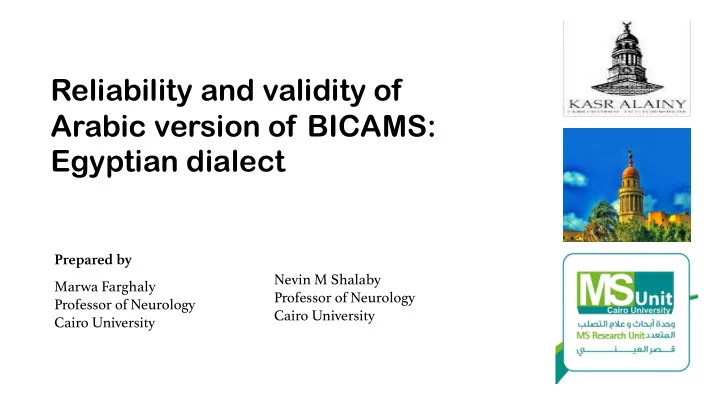

Reliability and validity of Arabic version of BICAMS: Egyptian dialect Prepared by Nevin M Shalaby Marwa Farghaly Professor of Neurology Professor of Neurology Cairo University Cairo University
Epidemiology of MS in Arab world While Middle Eastern and North African (MENA) countries were previously considered areas of low– moderate risk of MS, 1 recent evidence now suggests a rising prevalence of MS in this region. 2,3 1.BrowneP,ChandraratnaD,AngoodC,etal.AtlasofMultipleSclerosis 2013: a growing global problem with widespread inequity. Neurology . 2014;83(11):1022–1024. 2. Deleu D, Mir D, Al Tabouki A, et al. Prevalence, demographics and clinical characteristics of multiple sclerosis in Qatar. Mult Scler . 2013; 19(6):816–819. 3. Alroughani R, Ahmed SF, Behbahani R, et al. Increasing prevalence and incidence rates of multiple sclerosis in Kuwait. Mult Scler . 2014; 20(5):543–547.
MS Base data
13.7%
Why Validating a cognitive battery for MS? The lack of Arabic tests matching Egyptian culture as well as being non-education based is an obstacle in neuropsychological assessment of patients in Egypt.
Why Choosing BICAMS ? • Short comprehensive battery • Non education based • Not culture oriented • Proven reliability and validity across different languages • Standardized international Validation steps
Wh Why it it is is imp importan ant to have e an an Ar Arabi bic versi sion n of BICAM AMS 22 countries Population:450 million Language: Modern standardized Arabic (official language in 15 countries and co-official in the rest)
Arabic Dialects Distribution Egyptian dialect is the most popular, recognizable and widely understood dialect by Arabic speakers around the world.
Egyptian BICAMS Version work Up
Participants • Ninety MS patients were recruited from Kasr Al-Ainy MS Unit (KAMSU) in Cairo University consecutively between March and July 2017. Around 817 patients with MS diagnosis based on the revised McDonald’s criteria visited KAMSU during this period either as new comers, regular follow up visits or in relapse, only patients fulfilling inclusion criteria were recruited [>18; no visual impairment, no relapse in 4 weeks]. • The control group included 85 healthy participants.
Methodology: Ø Step (1): Standardization and Translation of Test Stimuli. BICAMS includes 3 tests: • Symbol digit modality test (SDMT) • California verbal learning-II (CVLT-II) • Brief Visuospatial Memory Test-revised (BVMT-R) The 3 tests were translated and culturally adapted into the Arabic language, Egyptian dialect.
The SDMT (oral) presents a series of nine symbols, each paired with a single digit in a key at the top of a standard sheet of paper. Participants were asked to say the digit associated with each symbol as rapidly as possible for 90 sec. The number of correct responses were recorded.
The California verbal learning Test -II (CVLT-II): A list of words was translated and retranslated from English to Arabic by a professional translator. Four semantic categories were used: cooking utensils, vegetables, clothes, and tools. Cooking utensils were chosen because this matches familiarity and frequency in Egypt culture were used. The total number of recalled items over the five learning trials was calculated (CVLT TL).
Brief Visuospatial Memory Test-revised (BVMT-R): To assess visual/spatial memory. Six abstract designs, with no semantic associations to stimuli in the culture or language in Egypt, were used. The total score of the three trials was calculated (BVRT TL).
Methodology (cont.): Step (2): Standardization and Translation of Test Instructions. • All information from the test manual necessary for administration and interpretation was translated, back translated, and checked for errors in Arabic language (Egyptian Dialect). • All examiners were trained to use standardized instructions in Arabic language. Short comprehensible sentences easily used.
Methodology (cont.): Step (3): Test-Retest Reliability. Forty-eight MS patients and 44 healthy volunteers were assessed on two occasions separated by two weeks to test reliability. All tests and procedures were identical to the first visit with the same examiner and all retests were scored with the same rater who scored the first visit test.
Methodology (cont.): Step (4): Criterion-Related Validity. MS sample was compared to the healthy control group to determine if BICAMS is sensitive to MS disease state. Impairment on individual tests was defined as -1.5 SD below reference group means.
Test Reliability All subjects Patients HC retested N=48 N=44 BICAMS N=92 Sub-Tests r P r P r P SDMT 0.85 <0.001 0.85 <0.001 0.71 <0.001 CVLT-II 0.65 <0.001 0.61 <0.001 0.63 <0.001 BVMT-R 0.75 <0.001 0.68 <0.001 0.67 <0.001
Test Validity BICAMS MS patients HC P value Sub-Tests SDMT 39.2±13.3 50.9±10.8 <0.001 SDMT Re-test 42.65±15.14 57.05±11.21 <0.001 Total CVLT 2 53.7±10.5 59.6± 8.5 <0.001 Total CVLT 2 Re-test 61.6±10.11 66.24± 7.95 <0.03 Total BVMT-R 19.7± 9.2 25.4± 8.7 <0.001 Total BVMT-R Re-test 23.09± 10.28 31.83± 4.86 <0.001
Cut off values of sub-tests: Impairment was defined as -1.5 SD below mean. The cut off scores were 34 in SDMT, 46 in CVLT TL, and 12 in BVMT-R TL. MS patients HC (n=90) (n=85) BICAMS P-value Impaired Not impaired Impaired Not impaired subtests n(%) n(%) n(%) n(%) SDMT 28 (31.1%) 62(68.9%) 5 (5.8%) 81(94.2%) <0.001 Total CVLT-II 17 (19.5%) 70 (80.5%) 6 (7%) 80 (93%) 0.015 Total BVMT-R 21(23.9%) 67 (76.1%) 7(8.1%) 79(91.9%) 0.005
What did the Egyptian validation add to BICAMS? • New language validation with the most popular Arabic dialect in the Arab world that can make the test the most used test for cognitive assessment in MS Arab patients. • The validation of BICAMS in Egyptians showed a new cut off values for the different tests that are not found in the other validated test in other languages.
Recommend
More recommend